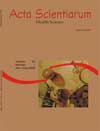Arterial anastomose with polydioxanone and polypropilene suture. Comparative study in dogs
Abstract
The objetive of this study was to compare the effects of the absorbable polidioxanone suture to the nonabsorbable polypropylene suture, in end-to-end anastomoses, using dog’s femoral arteries. Twenty dogs were separated in two groups for observation on the 7th and 30th post-operatory day. Each dog had its femoral arteries seccioned and then aproximated one side with separate stitches of polidioxanone 6-0 suture, and the other side with polypropylene 6-0 suture. For the statistical studies Fisher, Mac nemar, Wilsoxon, Mann-Witney and T of Student tests (a ≤ 0,05) were carried out. No significant differences were observed between the sutures employed in clinical evolution. The results obtained in the arteriographic and macroscopic avaliation were similar, as well as the morphological histologic analysis. In the morfometric histologic analysis the polypropylene suture showed a significantly higher number of foreign body giant cells reaction, comparing to the polydioxanone suture on the 7th or 30th post-operatory day. The results allow us to conclude that, in spit of the higher reaction of foreign body observed with the polypropilene suture, the polydioxanone suture showed similar results in dog’s arterial anastomoses.Downloads
Download data is not yet available.
Published
2008-05-06
How to Cite
Ferreira, M. V., Nigro, A. J. T., Bandeira, C. O. P., Fontes, C. E. R., Tormena, E. de B., Toda, L. Y., & Merenda, F. de C. (2008). Arterial anastomose with polydioxanone and polypropilene suture. Comparative study in dogs. Acta Scientiarum. Health Sciences, 23, 675-682. https://doi.org/10.4025/actascihealthsci.v23i0.2904
Issue
Section
Health Sciences
DECLARATION OF ORIGINALITY AND COPYRIGHTS
I Declare that current article is original and has not been submitted for publication, in part or in whole, to any other national or international journal.
The copyrights belong exclusively to the authors. Published content is licensed under Creative Commons Attribution 4.0 (CC BY 4.0) guidelines, which allows sharing (copy and distribution of the material in any medium or format) and adaptation (remix, transform, and build upon the material) for any purpose, even commercially, under the terms of attribution.
Read this link for further information on how to use CC BY 4.0 properly.























5.png)







